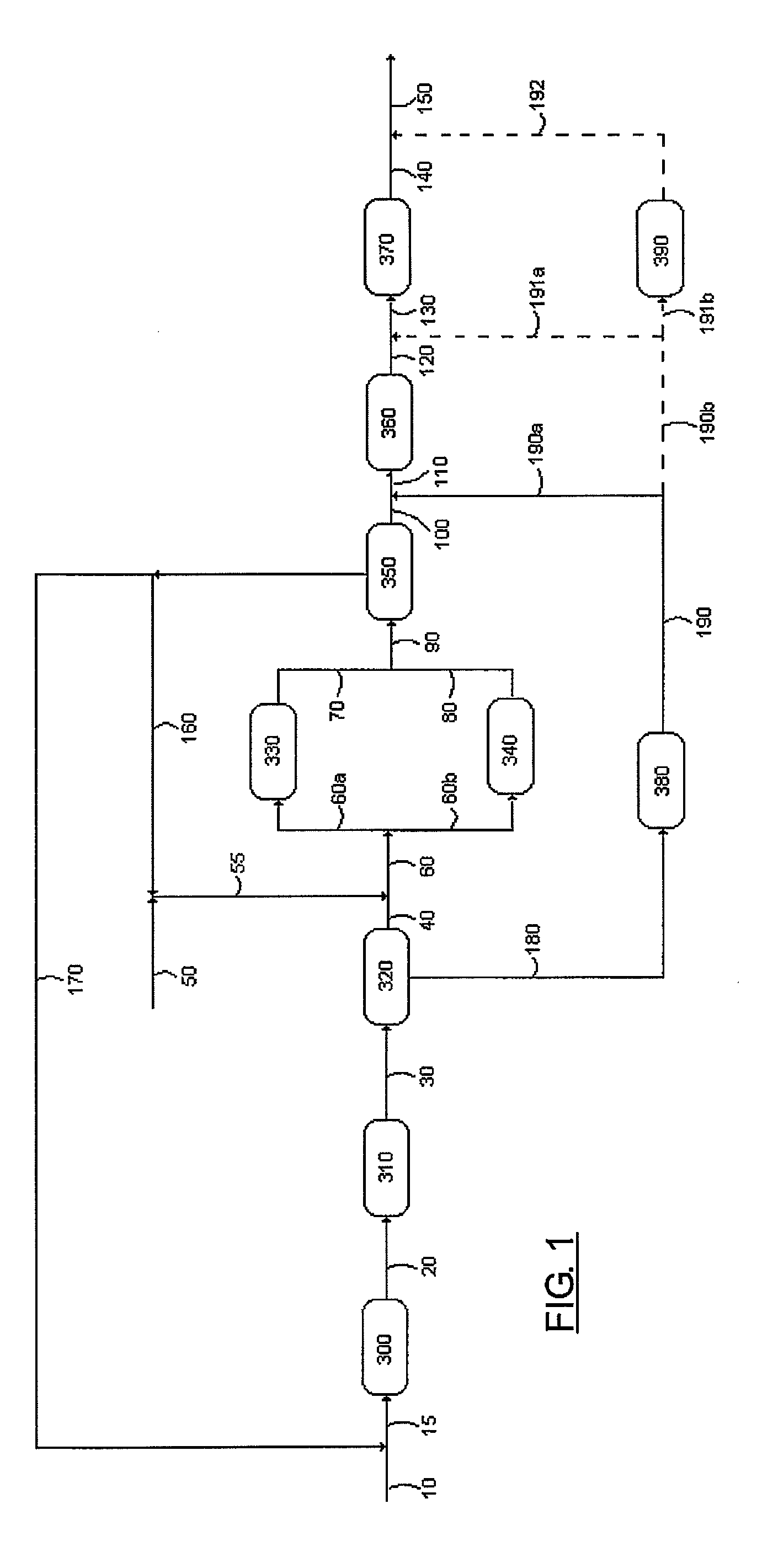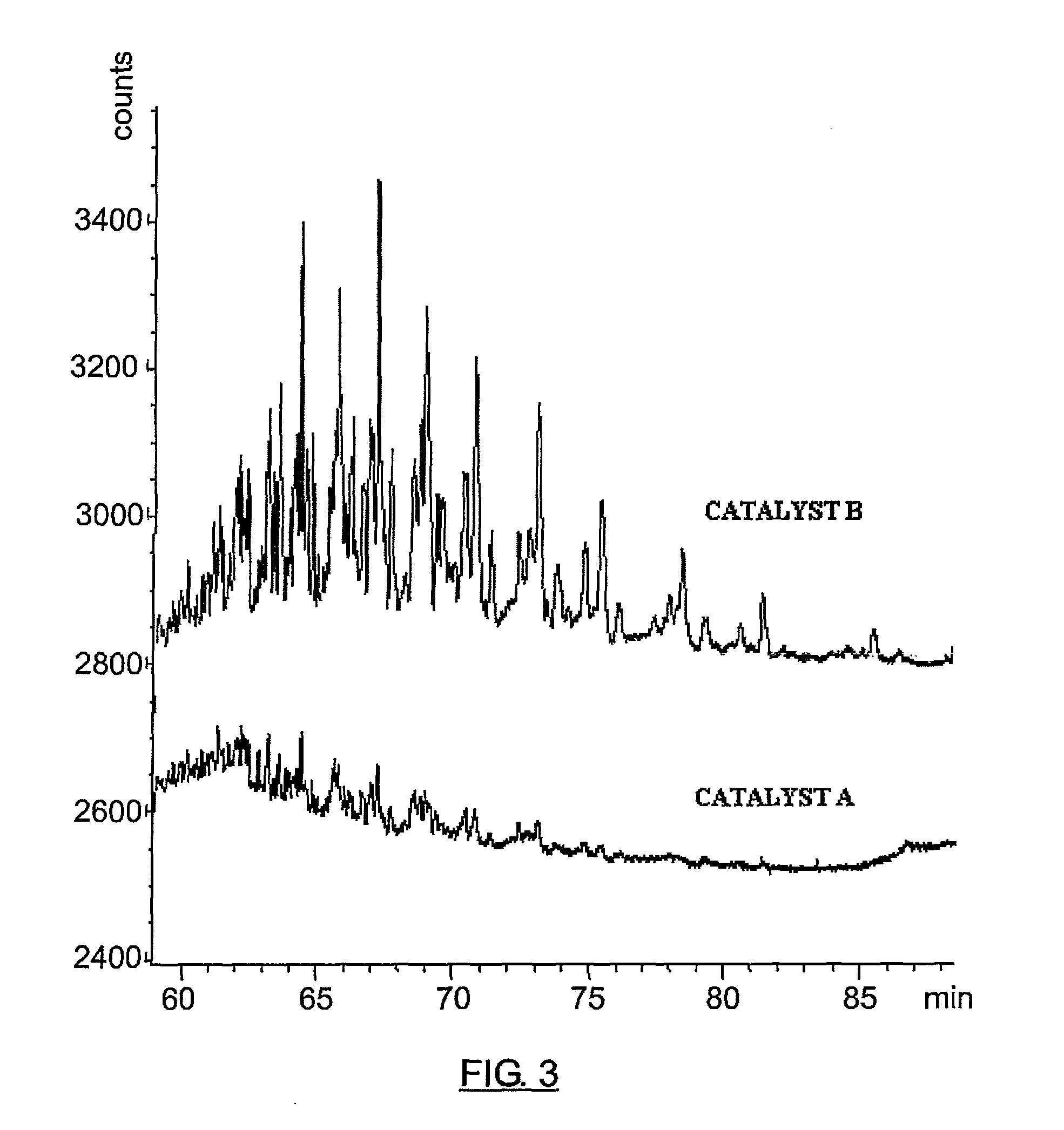Process for obtaining highly soluble linear alkylbenzene sulfonates
a linear alkylbenzene sulfonate, highly soluble technology, applied in the direction of hydrocarbon preparation catalysts, physical/chemical process catalysts, bulk chemical production, etc., can solve the problems of reducing the general yield, increasing fixed and operating costs, and degrading the quality of quality
- Summary
- Abstract
- Description
- Claims
- Application Information
AI Technical Summary
Problems solved by technology
Method used
Image
Examples
example 1
[0109]This example shows the advantages of using a Y zeolyte doped with 7% by weight of rare earth metals such as La, Ce, Pr and Nd (called catalyst A) in the alkylation of benzene with a mixture of olefins / paraffins, in comparison with the use of a commercial amorphous fluorinated silica-alumina (called catalyst B), widely used in this reaction at an industrial scale. Both catalysts were ground and sieved to obtain an equivalent particle size distribution. The benzene was dried with a molecular sieve to minimize the addition of water, and it was then mixed with a mixture of mono-olefins and paraffins that came from the dehydrogenation of paraffins and the selective hydrogenation of diolefins. The pilot plant alkylation tests were carried out in an isothermal fixed-bed reactor, with 24-hour reaction cycles followed by catalyst regeneration cycles by washing with benzene for the same time period. A standard cycle comprises a 24-hour reaction cycle at 140° C., LHSV=11 h−1 and a benzen...
example 2
[0129]This example shows the advantages of purifying the olefin / paraffin mixture coming from the dehydrogenation and selective hydrogenation steps, before it is reacted with benzene in the alkylation step. This reaction was catalyzed by a zeolite Y doped with a 7% (by weight) of rare earth metals such as La, Ce, Pr and Nd (called catalyst A). In this example, catalyst A is arranged on a fixed bed for the purpose of catalyzing the alkylation of benzene with purified and non-purified olefin / paraffin mixtures.
[0130]The purification step is carried out using an adsorbing bed, where a certain amount of a certain molecular sieve is placed. The selected molecular sieve is a zeolite, 13× widely used in processes for the selective elimination of aromatic components from a mixture of olefins and paraffins. The mixture of olefins and paraffins is passed through the bed to achieve a selective adsorption of non-linear compounds coming from the previous dehydrogenation step (or present in the fre...
example 3
[0141]This example shows the stability of zeolite Y doped with rare earth metals when it is used as a catalyst in the alkylation of benzene with olefins. A long sequence of cycles that use zeolite Y doped with rare earth metals has been carried out for the purpose of analyzing their deactivation rate. The thirty standard cycles were carried out, as previously defined in Example 1, at LHSV=8 h−1 and T=140° C. After each 24-hour reaction cycle, a washing cycle was carried out for 24 hours. The results are summarized in Table 12 and they are an average of the cycles considered.
[0142]
TABLE 12CyclesAverage conversion 1st to 10th99.611th to 20th99.621st to 30th99.6
[0143]As can be seen in Table 12, throughout this sequence of reaction / regeneration cycles, the average conversion was always above 99.5%, and in the thirtieth cycle no deactivation with respect to the initial cycles was detected. This means that the zeolite Y doped with rare earth metals is a very stable catalyst, maintaining a...
PUM
| Property | Measurement | Unit |
|---|---|---|
| Temperature | aaaaa | aaaaa |
| Fraction | aaaaa | aaaaa |
| Fraction | aaaaa | aaaaa |
Abstract
Description
Claims
Application Information
 Login to View More
Login to View More - R&D
- Intellectual Property
- Life Sciences
- Materials
- Tech Scout
- Unparalleled Data Quality
- Higher Quality Content
- 60% Fewer Hallucinations
Browse by: Latest US Patents, China's latest patents, Technical Efficacy Thesaurus, Application Domain, Technology Topic, Popular Technical Reports.
© 2025 PatSnap. All rights reserved.Legal|Privacy policy|Modern Slavery Act Transparency Statement|Sitemap|About US| Contact US: help@patsnap.com



